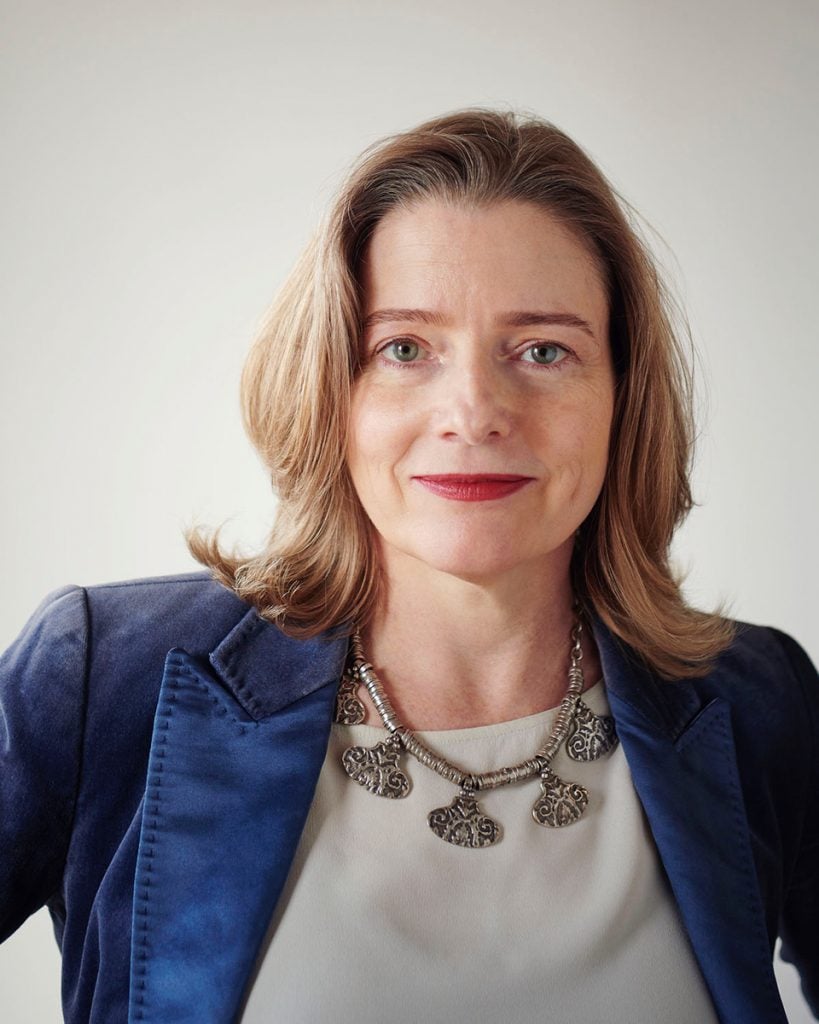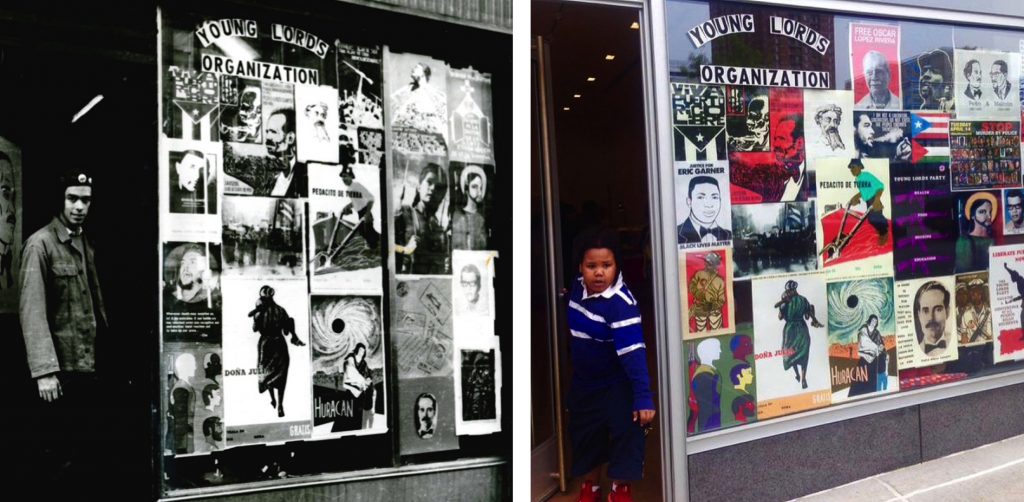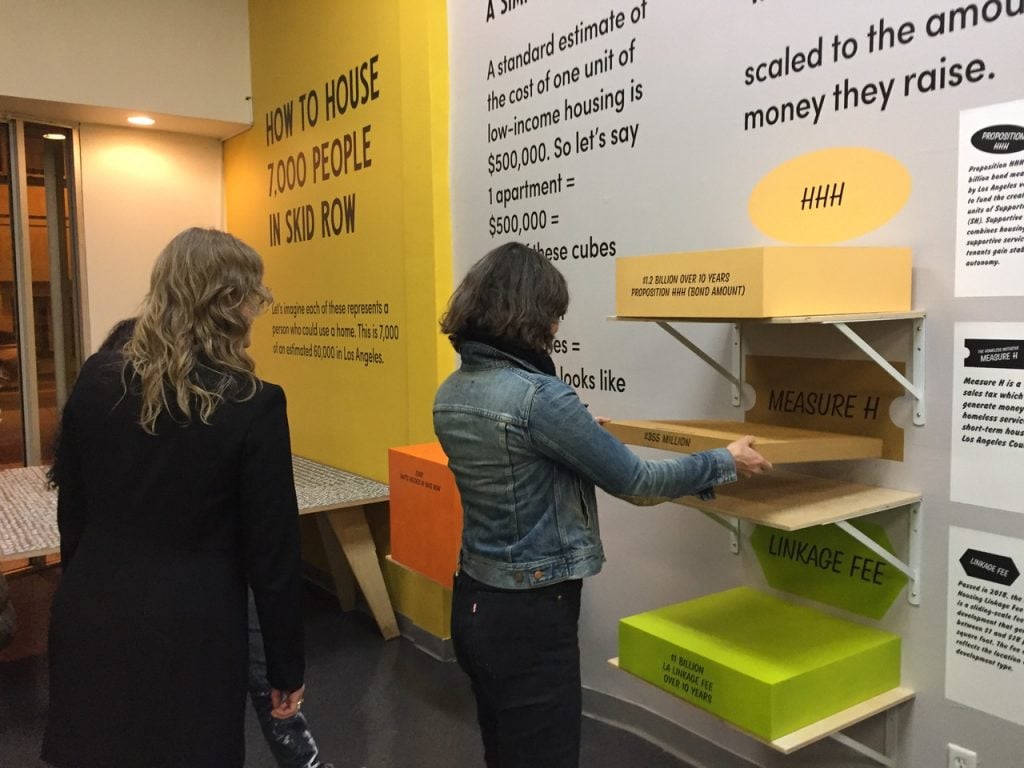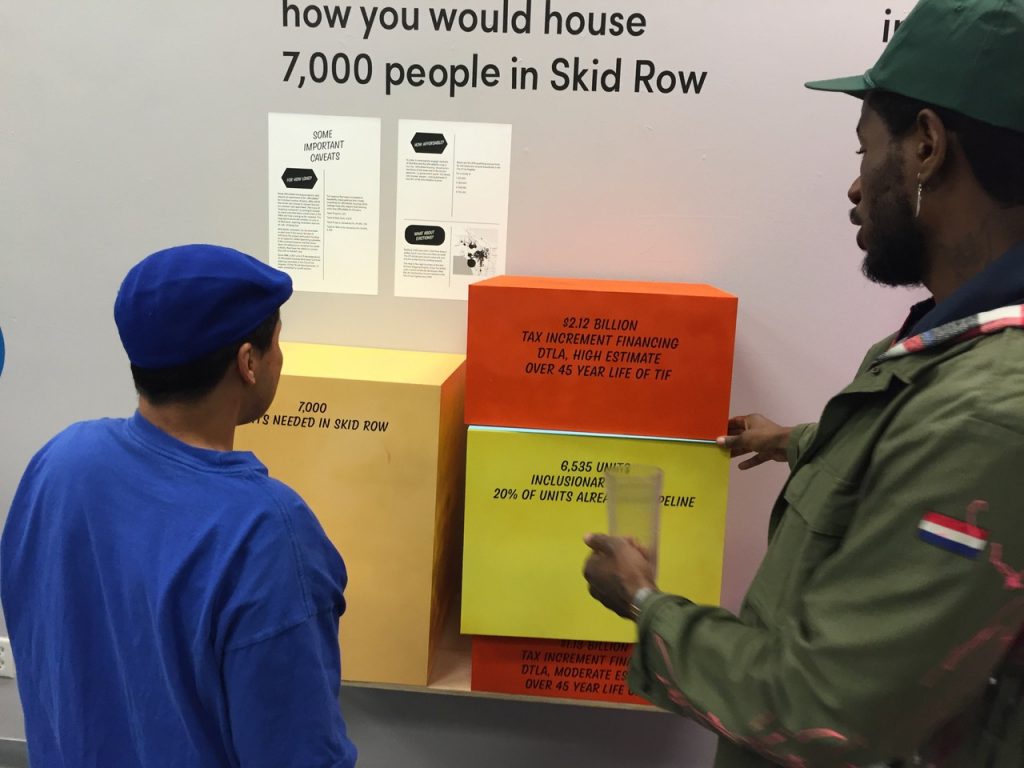People
A Blade of Grass Director Deborah Fisher on Why She Let Her Staff Go to Save the Social-Practice Art Organization
Fisher will become the only full-time employee of the socially engaged art nonprofit as it dramatically changes course.

Fisher will become the only full-time employee of the socially engaged art nonprofit as it dramatically changes course.

Taylor Dafoe

As cultural nonprofits around the globe reckon with fallout from the pandemic and the financial crisis, some have been forced to ask a very scary question: Can we survive this? A Blade of Grass, a beloved New York-based organization that promotes socially engaged art through events, editorial content, and a flagship fellowship program, is one of them.
On the surface, its dire situation makes sense. Socially engaged art is not constructed in a siloed studio; it’s born out in the world—and promoting art like that is difficult to do when society is in various states of lockdown.
But the pandemic didn’t just put A Blade of Grass in a precarious position. It revealed the precariousness of the position it, and so many organizations like it, were already in—beholden to grants, donations, and board contributions to stay afloat—and then exacerbated it. Suddenly, and seemingly out of nowhere, the end of the organization was in sight.
Deborah Fisher, A Blade of Grass’s executive director, had to make an unenviable decision. She could retrofit the organization’s model to a pandemic-shaped world, continuing to employ her full-time staff, and ask an increasingly depleted pool of cultural funders for more and more money. Or she could make changes—big, fundamental, tough changes that would necessitate the sacrifice of people’s jobs for the prospect of a brighter future.
She opted for change.
Beginning next month, A Blade of Grass will undergo a dramatic restructuring which will see it end its celebrated fellowship program, which has supported the work of such artists as Simone Leigh, Shaun Leonardo, and Dread Scott, in favor of fewer and more specific projects developed through commissions. All five of the nonprofit’s full-time staff will be let go with an additional pay period’s worth of severance, while Fisher will take a 10 percent pay cut and give up her benefits to remain the only employee.
Just before she went public with the news, Artnet News spoke with Fisher about the decision, the future of her organization, and the problem with the nonprofit model.

Laurie Jo Reynolds, Installation for Tamms Year Ten Family Room, “A Proximity of Consciousness: Art and Social Action,” School of the Art Institute of Chicago, September 20 – December 20, 2014. Photo: Soohyun Kim. Courtesy of A Blade of Grass.
So much of the last six months has been marked by this sense of wait and see, wait and see. When did you know that A Blade of Grass would need to change lest it cease to exist?
This moment stopped being a moment and started being the new normal sometime around summer. That’s when it became very clear that the Trump administration has absolutely no capacity for managing a public health crisis. And even countries that were doing a “good job” were finding that the virus itself is fairly persistent.
At the same time, the civil unrest and the threats to democracy were really consuming a lot of our donors’ mindshare. It changed where they wanted to give. There was so much upheaval and it was seriously impacting what our donor base wanted. The other thing we—the board and myself—started to fully realize is that it wasn’t just that we had a deficit this year. We also didn’t necessarily have a fundraising strategy moving forward because we still couldn’t have a party or take a trip or otherwise interface with the work on a very tangible level. That’s generally such a key part of our fundraising strategy because socially engaged art projects like those we promote are highly conceptual. They’re happening in places that we’re often not even invited to—a prison or a reservation, for example. So we needed these opportunities to get people in front of the work to make it feel real.
At that point, you were between a rock and a hard place. You had to choose between keeping the status quo while continuing to employ your staff—even if it meant the organization’s ultimate end—and changing fundamentally, which meant people would lose their jobs. How did you navigate that decision?
As I see it, there are two primary responsibilities that any nonprofit has. The first is to the people it employs, to treat them with dignity and respect. Especially in America right now, a job isn’t it simply a paycheck or an opportunity to advance yourself. It is also things like your healthcare—things that jobs shouldn’t be, but that they are, and we need to be accountable for that.
The other responsibility that any nonprofit has is to its mission. A Blade of Grass has resources that do not belong to me or the board or our donors. They literally belong to the public and they’re in the trust of the public. We are stewards of that money and we are supposed to spend it on a mission—doing mission-driven work and serving a particular community. We wound up in a situation where we had very few resources.
The way that we were doing the fellowship program was predicated on having operating reserves. We’d have to fundraise every year, but we did also have what is essentially a savings account in the form of an operating reserve. For the last seven years, we have been able to commit funding to that reserve. This year, we didn’t have enough to do that. We were left with a choice: to go on with the status quo for another half a year, which we have enough money for, or pull back and continue our work indefinitely in a form that is more economically sustainable, one in which we don’t have to put up hundreds of thousands of dollars from our savings account every year.
We chose the latter. We chose our mission. It’s an even bigger responsibility than our responsibility to employees. We have a commitment to perpetuate our mission. It’s not in service to our mission to save five people’s jobs for less than a year at the expense of serving the community that we support for the foreseeable future.

Recreation of the original storefront window of the Young Lords Party in East Harlem, 2015 Hunter East Harlem Gallery. Left: Juan Gonzalez at the original headquarters of the Young Lords Party in East Harlem, 1969, by Hiram Maristany ©. Courtesy of Miguel Luciano.
How do you tackle that process in a humane way?
We gave staff two months’ notice. We are able to provide a severance package. I’m trying to ensure that I know where employees want to be going and how I can help them get there. I’ve been spending a lot of time emailing people and telling them how great my employees are so that their resumes can get to the top of the pile.
These moves were necessary; they don’t have to do with anybody’s performance. The board and I feel a real commitment to helping and doing what we can.
As much as the pandemic has impacted socially engaged art in a specific way, A Blade of Grass’s plight in this moment is not necessarily unique. How does this moment illustrate the flaws in our nonprofit funding model?
There are a lot of things about the way that we are funding the arts that don’t work. There’s almost no government funding. There’s almost no foundation support. And what we’re supporting when we support the arts is very unclear for many. These questions create systemic problems that arise all the time and they inform decisions like ours. In order to commit a job to a person, I need to be able to say not just that I have the ability to pay right now. I have to say that I can reliably reproduce this funding year after year. And there is nothing about arts funding that actually lends itself to that. Nothing.
In your mind, what responsibility do board members have to step up in a situation like this? Did you have with conversations with them about giving more?
The essential work of a nonprofit is to accept generosity and transform it into mission-driven work. In order for this to be effective, the giving really does have to function as a gift—it has to be given freely to support the mission. And the organization has to be able to receive gifts. It has to have a business model that reduces reliance on each giver, and leadership that is accountable to the mission.
When these conditions aren’t met, gifts turn into transactions and the donors’ needs are met instead of the mission’s. This is what we are more accustomed to—all the little transactions that get created with each donation, grant, and partnership. In this highly fractured and highly transactional framework in which the organization has no true compass and is trading itself constantly in exchange for the ability to keep the lights on, it makes a lot of sense to demand that the giver take responsibility for the organization. But the costs of that are huge, and in no way theoretical.
We have never organized a board of people who hold the purse strings. What we’re trying to create is something that is an alternative to that model. Everybody is so angry about museum boards right now and it makes sense. They wield an incredible amount of unilateral power because they’re funding the organization and they’re doing it in ways that reasonably push their own interests forward.
The board of a public charity needs to be able to represent all of the people that it’s trying to serve and needs to be responsible for a wide variety of stakeholder opinions. Socially engaged art projects are community-driven; they work actively with power dynamics in communities and the artists are actively trying to move and share power. So we need to look at our own institutional power if we’re going to work with them well. We need to, as much as possible, make sure that we’re creating a sense of accountability at the board level.

Los Angeles Poverty Department installation images of “How to House 7,000 People in Skid Row,” 2020, at Skid Row History Museum and Archive, Los Angeles, CA. Courtesy of A Blade of Grass.
And that did turn into very difficult decisions. Right now, we don’t have the money to commit to payroll. That is a very difficult situation to be in. But we don’t have a board that is simply on the hook for making that problem go away. We have a board that is responsible for understanding that problem and helping me chart a new course towards financial sustainability.
We can either perpetuate the same problems with power and wealth and inequality that we’re all so angered by right now, or we can commit to building something different and new. That is not an easy process and it doesn’t mean that nobody gets hurt. But we are committed to this idea that everybody needs to be an equal participant on the board—and that the board isn’t simply an ATM for the institution.
That makes sense on an ideological level, but this is far from an ideological time. When confronted with the prospect of your entire staff losing their jobs, were you tempted to compromise and seek a different relationship to the board for the organization?
If you’re asking if I have a responsibility to ask for more money in a time like this, the answer is yes. My job is to ask for money because that’s the funding model. If we’re facing a deficit, my job is to ask for more money and I did that.
But I want to make it clear that there’s a difference between asking for more money and doing right by my employees. Even if I had gotten a year’s worth of payroll covered, for example, I still wouldn’t have been able to sustain that without changing the way that we’re actually doing business.
The problem that we were facing is not simply one year of deficit. The problem was that we are now living in a world in which we can’t introduce people to our work. So we need to do our work differently—in a way that plugs into more and different funding models. There’s another opportunity in this, which is to really rethink what we’re fundraising around and to create a better business model. That might mean getting smaller for a little while.

Los Angeles Poverty Department installation images of “How to House 7,000 People in Skid Row,” 2020, at Skid Row History Museum and Archive, Los Angeles, CA. Courtesy of A Blade of Grass.
Let’s talk about the ways in which the organization will change. How do you see those changes leading to a more sustainable model of operation?
The model of the organization right now is almost entirely organized around a big program that we administer [ABOG’s Fellowship for Socially Engaged Art, which awards $20,000 grants to eight fellows annually]. It takes the course of the whole year and informed many of the other things that we do like programming and advocacy. Instead of that, we’re going to be doing two things.
The first thing is to stop for a second and listen to the artists that we’ve worked with so far. We want to make whatever we make in a way that is maximally useful to them, a way that is respectful to them. We will be shifting from a programmatic focus to more of a project focus—something that’s more like commissioning.
By calling it that—”commissioning”—what we’re doing is making it easier to understand that we’re organizing around one project at a time. And then we’re working to help add value to that project on a case-by-case basis. What that means for each project will probably vary a lot.
Historically, we’ve been lucky in that we’ve been able to do a lot of different things to support socially engaged art projects. In addition to direct funding, we have done a certain amount of project management for certain initiatives. We have done a lot of field research that helps us understand how communities and artists are interacting. We do content creation, films, and other things that help secondary audiences see the work. We make public programs that are both conversations about art but also direct experiences of art projects. What we’re hoping to do now is to take the experience that the organization has accumulated and very slowly and experimentally start applying it to projects that speak to the time.
We don’t know what the future is going to be. Everything is so up in the air right now. It’s like we’re all in the process of feeling the future being born. I think that, more than anything else, is the most important focus for the organization: to be very open to listening while that happens, to be present for it, and not try to assert what we’re going to do. The first thing we’re going to do is listen.